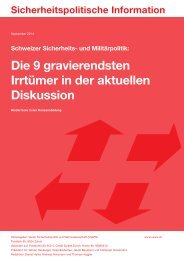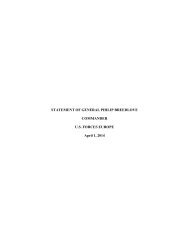FULLTEXT01
FULLTEXT01
FULLTEXT01
You also want an ePaper? Increase the reach of your titles
YUMPU automatically turns print PDFs into web optimized ePapers that Google loves.
TACTICAL THOUGHT<br />
2014 September 29 th<br />
Figures<br />
Figure 1. The research design. 18<br />
Figure 2. The empirical generalization of the term Irregular Warfare 48<br />
Figure 3. An overview of differences between Regular and Irregular Warfare 55<br />
Figure 4. Background factor contents and distribution. 58<br />
Figure 5. Summary of civilian education distribution. 59<br />
Figure 6. Summary of military education distribution. 59<br />
Figure 7. Axis 1-10, Eigenvalue results from MCA calculations. 65<br />
Figure 8. Graph of Specific Modified Rates for axis 1 – 16. 66<br />
Figure 9. Axis 1. Results of coordinates and contribution of answer categories. 67<br />
Figure 10. Distribution of the answer categories used for interpretation of axis 1. 68<br />
Figure 11. Axis 2.Results of coordinates and contribution of answer categories. 69<br />
Figure 12. Distribution of the answer categories used for interpretation of axis 2. 70<br />
Figure 13. Axis 3. Results of coordinates and contribution of answer categories. 71<br />
Figure 14. Axis 4. Results of coordinates and contribution of answer categories. 72<br />
Figure 15. Summary chart of axes content and thought perspective label. 73<br />
Figure 16. The model of the space of statements structured by axis 1 & 2. 75<br />
Figure 17. Examples of basic capabilities and characteristics for the four tactical types. 77<br />
Figure 18. Distribution graph 1; Unit affiliation, types, background and role 2011. 79<br />
Figure 19. Distribution graph 2; Age, Rank, Military and Civil Education. 81<br />
Figure 20. Distribution graph 3; Missions; roles, numbers, area and combat experience. 83<br />
Figure 21. Symbolic capital structure of the space of statement. 87<br />
Figure 22. Individual distribution in relation to the tactical types in the model. 90<br />
Figure 23. Individual distribution in the model according to command roles. 91<br />
Figure 24. Graph showing non-centric distribution of officers in the space of standpoints. 92<br />
Figure 25. Military Symbolic Capital structure in the space of statements. 102<br />
Figure 26. Appendix 1. An overview of American definitions 2009-1940. 14<br />
Figure 27. Appendix 1. An overview of modern definitions. 19<br />
Figure 28. Appendix 1. Summary of views on Irregular Warfare, Period One. 31<br />
Figure 29. Appendix 1. Summary of views on Irregular Warfare, Period Two. 48<br />
Figure 30. Appendix 1. Summary of views on Irregular Warfare, Period Two. 49<br />
Figure 31. Appendix 1. Summary of views on Irregular Warfare, Period Three. 65<br />
Figure 32. Appendix 1. Summary of views on Irregular Warfare, Period Three. 66<br />
Figure 33. Appendix 1. Summary of views on Irregular Warfare, Period Three. 67<br />
Figure 34. Appendix 1. The result of the doctrine and literature analysis – Question 1. 71<br />
Figure 35. Appendix 1. The result of the doctrine and literature analysis – Question 2. 72<br />
Figure 36. Appendix 1. The result of the doctrine and literature analysis – Question 3. 73<br />
Figure 37. Appendix 1. Overview of characteristics of Regular and Irregular Warfare. 75<br />
Figure 38. Appendix 4. Table 1. The 15 chosen questions with 41 modalities. 1<br />
Figure 39. Appendix 5. Table 2. The 15 chosen questions with 41 modalities. 1<br />
Figure 40. Appendix 8. Overview of the result comparison of COIN doctrines. 13<br />
Figure 41. Appendix 9. Inter-assessment reliability test of axis 1. 1<br />
Figure 42. Appendix 9, Inter-assessment reliability test of axis 2. 2<br />
v





